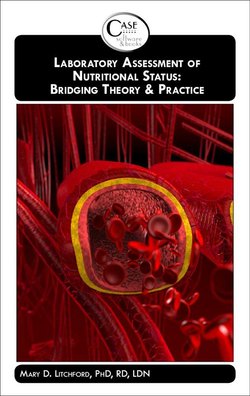Читать книгу Laboratory Assessment of Nutritional Status: Bridging Theory & Practice - MARY LITCHFORD - Страница 12
На сайте Литреса книга снята с продажи.
Assessment of Protein Status
ОглавлениеAssessment of protein status is essential for baseline assessment and to predict risk for malnutrition and skin failure. A patient’s protein status is a reflection of the body’s ability to synthesize dispensable amino acids (DAA) and to absorb and utilize indispensable amino acids (IDAA). As the protein status declines the patient is at higher risk for infection, delayed wound healing and new skin breakdown. The traditional method to estimate visceral protein status is using a variety of lab test results including retinol binding protein level, prealbumin (transthyretin) and serum albumin. However all of these measures are negative acute phase proteins and are dramatically affected by inflammatory processes. Changes in these values do not appear to reflect changes in nutritional status. For more information refer to Protein, Blood, for more information on retinol binding protein, prealbumin and albumin.
Nitrogen Balance Studies
Nitrogen balance studies reflect the balance between exogenous nitrogen intake (by mouth or parenteral) and renal removal of nitrogen containing compounds (urinary, fecal, wound and other nitrogen sources). Nitrogen balance studies are often part of research studies to determine if the endogenous protein is being utilized. However, in a healthcare setting, nitrogen balance studies are not a measure of protein anabolism and catabolism because true protein turnover studies require consumption of labeled (stable isotope) protein to track protein utilization (Hoffenberg, 1966). The acutely ill patient is losing protein rapidly due to the inflammatory process, traumatic or surgical wounds. In addition, it is unclear if increasing exogenous protein will ameliorate the loss of endogenous protein. Adequate nutrition and specifically high biological value protein cannot circumvent the inflammatory metabolism, but may prevent excessive loss of muscle mass and immunosuppression (Griffiths, 1996).
Nitrogen balance studies are challenging to achieve because valid 24-hour urine collections are difficult to obtain unless the patient has a catheter. In addition, changes in renal function are common in patients with inflammatory metabolism, making standard nitrogen balance calculations inaccurate without calculation of nitrogen retention. In these patients, urea kinetics provides a more accurate estimation of nitrogen balance.
Urinary Creatinine
Creatinine is formed from creatine, a compound found almost exclusively in muscle tissue. Creatine is synthesized from the amino acids glycine and arginine with addition of a methyl group. It is a high-energy phosphate buffer, maintaining a constant supply of ATP for muscle contraction. Creatinine has no specific biologic function. It is continuously released from the muscle cells and excreted by the kidneys with little reabsorption. When a patient follows a meat-restricted diet, the size of the patient’s somatic (muscle) protein pool is directly proportional to the amount of creatinine excreted. The clinical significance is that men generally excrete larger amounts of creatinine than women do and that individuals with greater muscular development excrete larger amounts than those who are less muscular. Total body weight is not proportional to creatinine excretion. Creatinine excretion rate is related to muscle mass in healthy individuals.
The use of urinary creatinine to assess somatic protein status in a healthcare setting in which patients are consuming a mixed diet has its limitations. Creatine is a component of muscle meats which is converted to creatinine. The body can not distinguish between the two sources of creatinine. In addition, urinary creatinine can vary significantly within individuals, probably due to sweat losses. Urinary creatinine concentration as a biomarker of muscle mass is typically used only in research.
